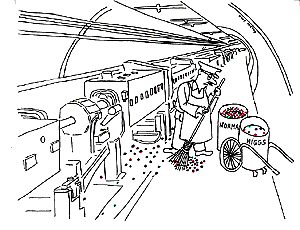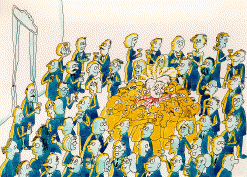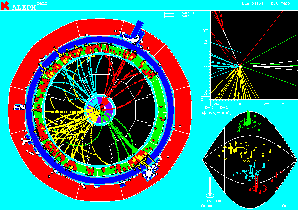|
|
|
|

|
|
|
When you get on the scale in the morning, you may be hoping
that it registers a smaller number than the day before --
you may be hoping that you've lost weight. It's the quantity
of mass in you, plus the force of gravity, that determines
your weight. But what determines your mass?
That's one of the most-asked, most-hotly pursued questions
in physics today. Many of the experiments circulating in
the world's particle accelerators are looking into the mechanism
that gives rise to mass. Scientists at CERN, as well as
at Fermilab in Illinois, are hoping to find what they call
the "Higgs boson." Higgs, they believe, is a particle,
or set of particles, that might give others mass.
The idea of one particle giving another mass is a bit counter-intuitive...
Isn't mass an inherent characteristic of matter? If not,
how can one entity impart mass on all the others by simply
floating by and interacting with them?
|
|
Higgs-like Particle Discovered!
On July 4, 2012, CERN announced the discovery of a new subatomic particle that's consistent with the Higgs boson—a particle that's been searched for since the 1970s. Whether it's the Higgs or something that closely resembles it,
a new particle is a historic discovery. See "
Higgs within reach
" on CERN's website.
 artwork:
CERN
artwork:
CERN
|
|
|
|
|

artwork:
CERN
Click
on the image above for a helpful cartoon explanation
of the Higgs Mechanism.
|
An
oft-cited analogy describes it well: Imagine you're at a Hollywood
party. The crowd is rather thick, and evenly distributed around
the room, chatting. When the big star arrives, the people
nearest the door gather around her. As she moves through the
party, she attracts the people closest to her, and those she
moves away from return to their other conversations. By gathering
a fawning cluster of people around her, she's gained momentum,
an indication of mass. She's harder to slow down than she
would be without the crowd. Once she's stopped, it's harder
to get her going again.
This
clustering effect is the Higgs mechanism, postulated by
British physicist Peter Higgs in the 1960s. The theory hypothesizes
that a sort of lattice, referred to as the Higgs field,
fills the universe. This is something like an electromagnetic
field, in that it affects the particles that move through
it, but it is also related to the physics of solid materials.
Scientists know that when an electron passes through a positively
charged crystal lattice of atoms (a solid), the electron's
mass can increase as much as 40 times. The same might be
true in the Higgs field: a particle moving through it creates
a little bit of distortion -- like the crowd around the
star at the party -- and that lends mass to the particle.

photo:
CERN
Scientists
at CERN use the enormous ALEPH
detector
in their search for the Higgs particle.
|
The
question of mass has been an especially puzzling one, and
has left the Higgs boson as the single missing piece of
the Standard Model yet to be spotted. The Standard Model
describes three of nature's four forces: electromagnetism
and the strong and weak nuclear forces. Electromagnetism
has been fairly well understood for many decades. Recently,
physicists have learned much more about the strong force,
which binds the elements of atomic nuclei together, and
the weak force, which governs radioactivity and hydrogen
fusion (which generates the sun's energy).
Electromagnetism describes how particles interact with photons,
tiny packets of electromagnetic radiation. In a similar way,
the weak force describes how two other entities, the W and
Z particles, interact with electrons, quarks, neutrinos and
others. There is one very important difference between these
two interactions: photons have no mass, while the masses of
W and Z are huge. In fact, they are some of the most massive
particles known.
The
first inclination is to assume that W and Z simply exist
and interact with other elemental particles. But for mathematical
reasons, the giant masses of W and Z raise inconsistencies
in the Standard Model. To address this, physicists postulate
that there must be at least one other particle -- the Higgs
boson.
The
simplest theories predict only one boson, but others say
there might be several. In fact, the search for the Higgs
particle(s) is some of the most exciting research happening,
because it could lead to completely new discoveries in particle
physics. Some theorists say it could bring to light entirely
new types of strong interactions, and others believe research
will reveal a new fundamental physical symmetry called "supersymmetry."

photo:
CERN
CERN scientists were unsure whether these events
recorded by the ALEPH detector indicated the presence
of a Higgs boson. Check out the links listed below
for the latest information on the search for the
Higgs Boson.
|
First,
though, scientists want to determine whether the Higgs
boson exists. The search has been on for over ten
years, both at CERN's Large Electron Positron Collider
(LEP) in Geneva and at Fermilab in Illinois. To look
for the particle, researchers must smash other particles
together at very high speeds. If the energy from that
collision is high enough, it is converted into smaller
bits of matter -- particles -- one of which could
be a Higgs boson. The Higgs will only last for a small
fraction of a second, and then decay into other particles.
So in order to tell whether the Higgs appeared in
the collision, researchers look for evidence of what
it would have decayed into.
In August 2000, physicists working at CERN's LEP saw
traces of particles that might fit the right pattern,
but the evidence is still inconclusive. LEP was closed
down in the beginning of November, 2000, but the search
continues at Fermilab in Illinois, and will pick up
again at CERN when the LHC (Large Hadron Collider)
begins experiments in 2005.
|
EXTERNAL
LINKS
For up-to-date information on the search for the Higgs boson:
LHC
Fermilab
ALEPH
(LEP experiment)
OPAL
(LEP experiment)
L3
(LEP experiment)
DELPHI
(LEP
experiment)
|